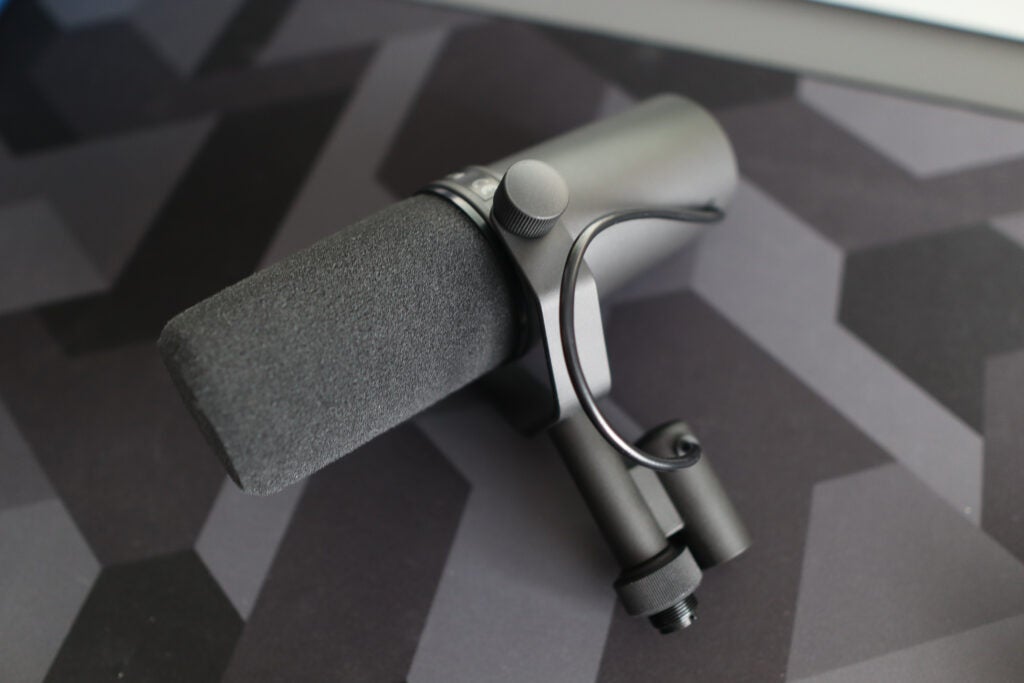Verdict
The Shure SM7B is an iconic dynamic microphone that lives up to its reputation with wonderfully clean, rich and detailed output. It’s also plug-and-play as long as you’ve got an XLR interface, but works beautifully, especially with its impeccable noise rejection.
Pros
- Class-leading pickup
- Plug and play with an interface and XLR cable
- Near-perfect noise rejection
Key Features
- Dynamic cardioid microphone::The SM7B features a cardioid pickup pattern that’s ideal for voices.
- XLR connectivity:It is also an XLR microphone, requiring an interface and XLR cable to work, although is plug and play.
Introduction
The Shure SM7B is one of those microphones that has gained iconic status with quite the reputation as one of the best all-round microphones money can buy.
Everyone from Michael Jackson to, well, me has used them, as it’s the choice for a lot of professional studios for music vocals, voiceovers and content creators on the interwebs. It doesn’t come cheap though, carrying a £379 / $399 price tag, making it a fair bit more expensive than some competent USB choices we’ve tested such as the Logitech G Yeti GX and SteelSeries Alias.
I’ve been testing the SM7B for the last couple of weeks to see if it’s worth the high asking price. Let’s find out.
Design
- Iconic shape
- Noticeably hefty
- No stand, interface or cable provided
The SM7B has an instantly recognisable shape to it, with a cylindrical main body split down the middle by both its wind shield and metal mount. The pop filter and shock mount are internalised, so there’s no unsightly obtrusions to get in the way of its style
At 765g, the SM7B is also especially hefty for what is ‘just’ a microphone and no mounting hardware, reinforcing its status as a quality product. This is also a simple microphone elsewhere too, with no onboard controls or even a headphone jack for onboard monitoring. Being an XLR choice, most of those tasks are down to the interface or mixer you’ve got the SM7B plugged into.
As mentioned previously, there isn’t a stand or anything else included, just the SM7B itself. This means you do have to provide your own stand and interface to get it working, but let’s face it – if you’re looking at one of these, you already knew that. The SM7B nonetheless screws into a stand with the mount that comes off the microphone’s body and metal mount, while there is also an XLR connector for plugging the mic into an interface or mixer.
It’s equally happy on a desktop stand or a boom arm, as I had mine on, although with the SM7B’s heavier weight, you’ll have to make sure your arm is up to the task for supporting it.
Performance
- Rich, detailed pickup
- Near-perfect noise rejection
- Convenient setup, although you will need an interface
As alluded to earlier, I’m someone who has had experience with the SM7B before, having used one on student radio for the best part of three years, so being able to revisit it 18 months after leaving university was a pleasure. It offers rich and detailed pickup with plenty of body and depth that makes it ideal for vocals, be them for music or voiceover work, and that’s in an untreated room with no soundproofing. In a studio environment, it’s even better.
The SM7B offers a singular cardioid pickup pattern that’s well-suited for vocals, while its noise-rejection is impeccable. It managed to block out the noise of my mechanical keyboard well, as well as the slightly noisier fans on my PC, and even when I had music playing from my Sonos Beam that was rigged up to my PC. When being around six inches from the head of the SM7B, it blocked out the music especially well, with only my voice audible in testing.
Setup was simple enough too, with the mic working plug and play with my Elgato Wave XLR interface along with an XLR cable from the SM7B to the interface and USB-C to USB-A cable from the interface to my PC. It was picked up on both Windows and macOS through Audacity without a hitch.
Features
- No real added extras present
The SM7B, as a straightforward microphone, is lacking in the features department, especially with no onboard controls, RGB or any software integration. Its job is simply for you to bellow into.
As much as it may seem contradictory to its price tag, I don’t mind that the SM7B is bereft of features, largely because of its intended use. While it has become a favourite of streamers in recent years, this is a microphone squarely aimed at professional use where things such as RGB lighting or software integration aren’t the be all and end all.
Latest deals
Should you buy it?
You want class-leading vocals
The SM7B excels with its fantastic performance with full-bodied pickup that’s ideal for vocals and voiceover work, while its impeccable noise rejection ensures it’s only you that’s heard.
You want a more affordable choice
Where the SM7B has always had an issue is with its high price tag, which means it’s only for those who’ve got the cash to pick one up. Otherwise, there are other choices at less than half its price that offers solid pickup and a rich feature set.
Final Thoughts
The Shure SM7B is an iconic dynamic microphone that lives up to its reputation with wonderfully clean, rich and detailed output.
It’s also plug and play as long as you’ve got an XLR interface, but works beautifully, especially with its impeccable noise rejection. A more ‘affordable’ choice is here is the Logitech Blue Sona, which we’ve also rated highly and offers more in the way of on-board controls. Even at its higher price point though, the Shure SM7B is still the one to beat.
How we test
During each microphone review, we conduct a series of recording tests that include sampling audio during ideal settings, with background noise applied and in an outdoor setting (where possible), to give you the best idea of how each device performs in real-world use.
Performance tested in a variety of conditions
Tested all available features
You might like…
FAQs
Does the Shure SM7B need an interface?
Yes, the Shure SM7B requires an interface to work as it’s an XLR microphone.
Does the Shure SM7B work on a boom arm?
Yes, the Shure SM7B works on a boom arm or desktop stand.










